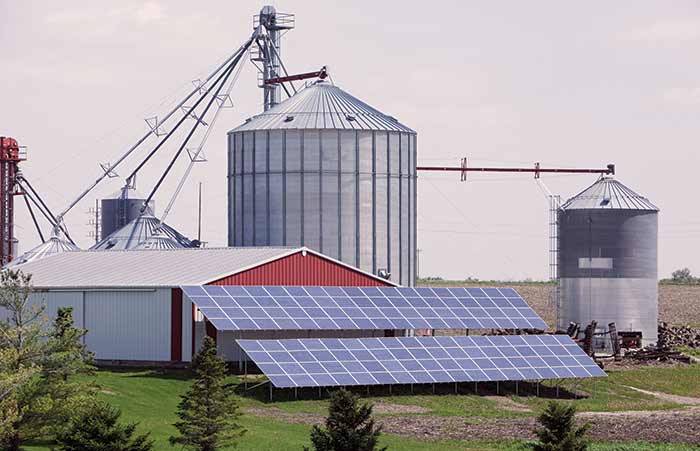
Could solar energy be an opportunity for your farm? The sun grows your crops, but it could also provide income and generate energy for your community.
My farm clients are some of the most resourceful and innovative business people I know. They are consistently exploring how they can improve their operations. The agriculture industry itself is full of new research and machinery such as auto-steer and precision planters, automated feeders, robotic milkers, and drones. Each season there are different fertilizers and improvements in animal and seed genetics. Though we can’t control the weather, farmers can use moisture sensors and drip tape to increase production and improve efficiency. Agriculture is an exciting industry that harnesses technology and applies it to natural processes.
Some farmers are first adopters, and some wait until after technology proves reliable and sustainable for the financial bottom line. These improvements help farming businesses increase profitability, efficiency, safety, and environmental sustainability. And while producers do still watch the weather forecast with great anticipation, success is hardly left up to Mother Nature and luck. Many rely on technology to outwit pests and increase yields.
Progressive ag producers have a lot of technology to choose from when it comes to making an investment in their farm, including energy sources. And with solar technology becoming less expensive and the abundance of available flat land, many of my clients are inquiring about these renewable energy opportunities.
Is the renewable energy tax credit still available?
The most practical benefit from a solar investment is the tax credit and depreciation on the equipment in year one and the reduction in near-term income tax liabilities. Currently, the renewable energy tax credit for solar energy systems is 30% for the 2019 tax year, and is available through December 31, 2021, with a gradual step down over the following two years.
| Date construction begins | Placed in service date | Tax credit amount |
|---|---|---|
| Before 1/1/20 | Before 1/1/24 | 30% |
| 1/1/20 — 12/31/20 | Before 1/1/24 | 26% |
| 1/1/21 — 12/31/21 | Before 1/1/24 | 22% |
Tax credits and Depreciation for a Solar Project
Here are a few things to remember as you consider a solar project:
- The cost basis for income tax depreciating of the solar equipment is reduced by one-half of the tax credit.
- No Section 179 is allowed on the solar equipment with the credit.
- 100% bonus depreciation is allowed.
- Solar equipment has a five year normal depreciable life otherwise.
Here is an example. Currently there is a 30% tax credit available for solar equipment, so if you spent $162,500 in 2019 you would get a $48,750 credit to offset your federal income taxes.
A review of the last few years of your Federal income tax returns and your current year income tax planning projections will let you know if you have an expected tax liability. If you don’t use all the credit in the current year, the credit is carried back to the immediate prior year. Any remaining credit is carried forward for up to 20 years.
The cost basis of equipment of $162,500 would be reduced by one-half of the credit ($24,375), which would make your depreciable basis in the equipment $138,125. Again, this is five-year depreciable equipment and Section 179 is not allowed, but you can take 100% bonus depreciation.
Return on investment
The payback on solar will depend on the price of energy in the future, and the tax code on this may change. As with any piece of equipment there is a tax savings if accelerated depreciation is used. A number of my clients considering solar like the financing terms offered. We advise taking a close look at your operation’s cash flow projections to determine if solar equipment is a good fit for your situation.
The tax credit and depreciation benefits will help cash flow related to the initial investment, but if additional funds are obtained, it may significantly help your decision to move forward. Applying for a USDA Rural Energy for America Program (REAP) grant may be appropriate for your operation. Your local utility company may have special offers, and your state may provide income tax credits or incentives as well. Taken together, these opportunities could help make the deal less daunting and reduce your financial risk.
Where to install a solar project
A good location for a solar project would be farm land or operating sites that will be in the family for years to come. In addition to the possibilities of investing in solar equipment, renting land to energy companies may bring in income as well. The leases are upward of 20 years and typically have been bringing in $1,000 to $1,500 an acre. The lease should be reviewed carefully by a professional before proceeding.
How we can help
For farmers, creating various income streams, finding efficiencies with technologies on the farm, using tax credits, USDA funds, rebates, and incentive programs all help the bottom line. Progressive farmers consider all these areas and evaluate and balance these investments the same way investment professionals balance a portfolio. Solar may not be right for your operation, but many producers have been running the numbers to determine if an opportunity is available before the existing tax credit runs out. CLA’s resources and agribusiness professionals are here to help. We can help you plan for a solar project, explore other renewable energy tax credits available, or simply sit down and talk about the future of your farming operation.
